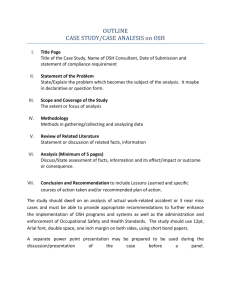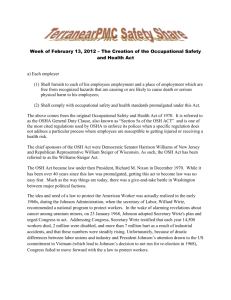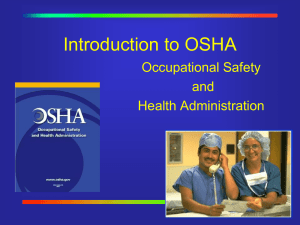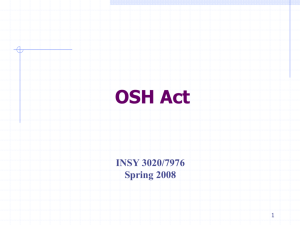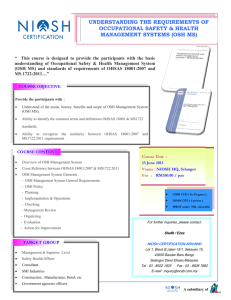The Occupational Safety and Health Act
advertisement
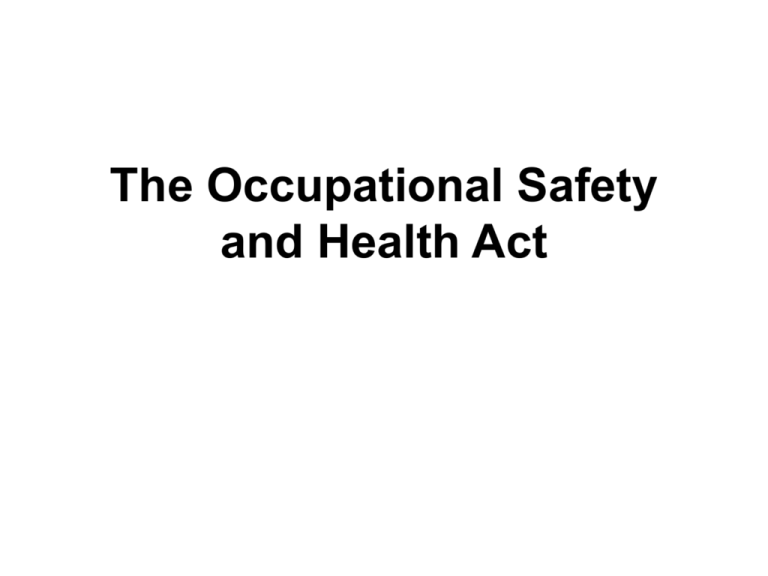
The Occupational Safety and Health Act Objectives • This class session is intended to familiarize students with the Williams-Steiger Occupational Safety and Health Act of 1970. Students should be able to: – Know the basic process that results in regulations – Appreciate the political and historical context of the Act – Know key provisions of the Act Introduction Where to regulations come from? • Much of our daily life is governed by regulatory agencies, but how did this happen? – Occupational Safety and Health Admin.and regulations were created because Congress passed OSH Act. – Congress passed the OSH Act because they believed it was a good idea – Citizens, labor unions, and others encouraged Congress • Therefore, we (the public) are the ultimate force behind the creation of laws and regulations. We, as a society, bring this upon ourselves to better the human situation OSHA History • The first 0ccupational safety and health laws in the U.S. stemmed from the dangerous conditions of post-Civil War factories. – Massachusetts passed a factory inspection law in 1877 – By 1890 nine states had factory inspection laws, 13 required machine guarding, and 21 had limited provisions for health hazards OSHA History • The Progressive Era of the early 1900s saw an increased interest in protecting workers’ health and safety. – Studies brought to light the deplorable conditions workers experienced – Several industrial disasters also helped raise awareness of occupational safety and health – These forces prompted Congress to create the Department of Labor in 1913. OSHA History • During the post-World War II era, the Federal government began to take a stronger role, – Some of the previous progress in worker safety and health was jeopardized. – A 1958 amendment to the Longshoremans, and Harbor Workers’ Compensation Act involved the Labor Department in standard setting and enforcement. – In 1960, the Labor Department issued a mandatory safety and health standard under the Walsh-Healy act. This was an unpopular action, and it prompted a “backlash” against Federal involvement in occupational safety and health. OSHA History • The mid 1960s saw increased awareness and interest, due to heighten awareness of occupational cancer, an epidemic of deaths among uranium miners, and Union efforts. OSHA History • In 1968 President Lyndon Johnson proposed a job safety and health program – “the shame of a modern industrial nation” that killed 14,000 and injured 2.2 million men each year. – In spite of support from organized labor and activists, Johnson’s proposal failed. – Several other acts were passed: • • • • The Service Contracts Act of 1965 Federal Construction Safety and Health Act of 1969 1966 Metal and Non-metallic Mine Safety Act Coal Mine Health and Safety Act of 1969. OSHA History • President Richard Nixon proposed safety and health legislation in August, 1969. – His version was criticized by labor and Democrats due to the proposed administrative board. – A more liberal bill, similar to the Johnson bill of 1968, was proposed by Representative James G. O’Hara of Michigan and Senator Harrison Williams, Jr. of New Jersey. OSHA History • Nixon supported the Williams bill after some changes were made, and it passed the Senate. • Representative William R. Steiger of Wisconsin offered a more conservative bill to substitute for the O’Hara bill, and it passed easily in the House of Representatives. • A House-Senate committee was formed to resolve differences between the two laws, resulting in the Williams-Steiger Occupational Safety and Health Act of 1970. Who is Covered by the Act • Applies to employers and employees in such varied fields as manufacturing, construction, longshoring, agriculture, law and medicine, charity and disaster relief, organized labor and private education. • Such coverage includes religious groups to the extent that they employ workers for secular purposes. • Does not include the United States or any state or political subdivision of a State Who is Not Covered by the Act • Self-employed persons • Farms at which only immediate members of the farmer's family are employed • Working conditions regulated by other federal agencies under other federal statutes. – Mmost employment in mining, nuclear energy and nuclear weapons manufacture, and many segments of the transportation industries; • Employees of State and local governments (unless the States has an OSHA-approved safety and health programs). Who is Not Covered by the Act • Other federal agencies are sometimes authorized to regulate safety and health working conditions in a particular industry; if they do not do so in specific areas, then OSHA requirements apply. – EPA regulates pesticides – DOT regulates transportation, – Etc. Major Provisions of the OSH Act 1. Introduction – “To assure safe and healthful working conditions for working men and women; by authorizing enforcement of the standards developed under the Act; by assisting and encouraging the States in their efforts to assure safe and healthful working conditions; by providing for research, information, education, and training in the field of occupational safety and health; and for other purposes. “ Major Provisions of the OSH Act 2. Congressional findings and purpose – Congress found workplace injuries and illnesses hinder interstate commerce. Therefore, its intent is to “to assure so far as possible every working man and woman in the Nation a safe and healthful working condition and to preserve our human resources”. Major Provisions of the OSH Act 3. Definitions • Several important terms are provided, including “employer”, “employee”, “occupational safety and health standard” 4. Applicability • “This Act shall apply with respect to employment performed in a workplace” Major Provisions of the OSH Act 5. Duties (A) Each employer - (1) shall furnish to each of his employees employment and a place of employment which are free from recognized hazards that are causing or are likely to cause death or serious physical harm to his employees; This is the “general duty clause” OSHA cites when no specific OSHA standard applies. Major Provisions of the OSH Act 5. Duties A. Each Employer 2. shall comply with occupational safety and health standards promulgated under this Act B. Each employee shall comply with occupational safety and health standards and all rules, regulations, and orders issued pursuant to this Act which are applicable to his own actions and conduct. Major Provisions of the OSH Act 6. Occupational Safety and Health Standards – Procedures are established allowing OSHA to “promulgate” regulations (“promulgate” means to give public notice, or first notice of; to make known; to publish; to proclaim regulations). – Variances from standards are allowed under certain circumstances. Major Provisions of the OSH Act 7. Advisory committees – Procedures for establishing the National Advisory Committee on Occupational Safety and Health. 8. Inspections, Investigations, and Recordkeeping – – – OSHA has the authority to enter and inspect. Employers must keep records. Employees can request inspections Major Provisions of the OSH Act 9. Citations – OSHA can issue citations for violations – Citations must be posted – Violations must be corrected 10. Enforcement – Employers may contest citations Major Provisions of the OSH Act 11. Judicial review – Employers may appeal – No one shall discriminate against an employee who complains to OSHA 12. 13. Occupational Safety and Review Commission Imminent Dangers Major Provisions of the OSH Act 14. Civil Litigation 15. Confidentiality of trade secrets 16. Variations, tolerances and exemptions 17. Penalties 18. State plans Major Provisions of the OSH Act 19. Federal agency programs 20. Research 21. Training 22. NIOSH 23. Grants to states Major Provisions of the OSH Act 24. Statistics 25. Audits 26. Annual report 27. Workmen’s compensation 28. Assistance to small business Major Provisions of the OSH Act 29. Assistant secretary of labor 30. Additional positions 31. Emergency locator beacons 32. Appropriations 33. Effective Date
